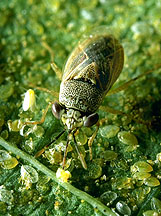|
|
Forum—Diet Critical to Mass-Rearing Beneficials
In this increasingly complex world, the idea of relying less on chemical pesticides and turning instead to nature to help solve our crop and livestock pest problems is not only ideologically appealing, but environmentally imperative.
However, to work most effectively with nature to protect our crops and animals, we need to use every modern scientific tool at our disposal. Biological control of pests is a holistic activity with several dimensions.
First, there's classic biological control. Many of the pests that now plague this country's crops and creatures came from other parts of the world; Columbus probably brought house flies along when he set sail from Spain in search of new lands. In their homeland, these pests had natural parasite or predator enemies to keep them in check. But in the New World, there were no such limits.
To fight these crop and livestock pests without routinely resorting to an arsenal of chemicals, we must trace their origins. For this reason, the Agricultural Research Service maintains laboratories in France, South America, Australia, and China, where our scientific explorers look constantly for natural enemies of the pests that have migrated to the United States.
But it's not enough simply to find a natural enemy of our pest enemies. Once we've collected these potentially beneficial insects, they must be tested rigorously to ensure that if they're loosed against the pest population, they won't turn next to a crop for nourishment when the pest supply is depleted.
Sometimes a natural enemy is already present in this country to combat a pest, but it exists in such low numbers that it can't control the pest to the degree we demand. Then we use augmentation--that is, rearing large numbers of the beneficial insect to turn loose in the fields or on the range.
This is a simple concept that's anything but simple to accomplish. It's not easy or inexpensive to mass-rear biocontrol insects, especially when you need to provide a host for the young beneficials to eat. It means you, theoretically, have to grow the pest, too.
To circumvent this problem, ARS scientists have put considerable effort into developing artificial diets to sustain our insect helpers.
An insect responds to certain cues—perhaps something it sees, perhaps something it feels or smells—to eat and to reproduce. We have to identify those cues and learn how to mimic them. It's not enough to simply provide a diet that will keep the beneficial alive; the diet must help it to thrive and produce multitudes of offspring. To meet the needs for which nature typically provides through the host insect, we must have a thorough knowledge of the biology and physiology of both the insect we want to promote and the insect we hope to control.
For example, many insects are thought to suck liquid juices out of their host's body, so scientists tried making liquid diets. But the liquid diets failed many times.
With more investigation, we've now learned that when predatory insects bite into their host, they inject juices that partially digest the host's body parts. If we provide the predators with a wholly liquid diet, their injected juices can be lost in the mixture—and thus aren't available for use again in digesting the material they ingest.
We must use cutting-edge science to unlock these secrets of nature, to know exactly how an artificial diet must taste, smell, and even feel. We have to understand the beneficial insect's needs if we are to produce massive populations--not thousands of insects, but millions—of these natural enemies to fight our battles in the field.
Even producing large numbers of helpful insects isn't enough. We have to ensure that our lab-raised beneficials are strong enough to compete in the wild, to hunt down and eradicate our insect enemies. To make sure we're not breeding that competitiveness out of our laboratory insect populations, we have to conduct tests to ensure the beneficials are sufficiently aggressive.
As we work to build up populations of biocontrol insects, we must also identify the proper measures producers and others must take to ensure that beneficials already in place are protected. This is called conservation—doing things to properly manage the natural enemies that inhabit an area. This often means minimizing pesticide applications or providing a habitat that protects the beneficials from a harsh environment.
As you can see, there are many parts to the equation for adapting nature's methods to control crop and livestock pests. Scientists have been struggling with this multifaceted problem for at least 30 years, but only in the past 5 has technology enabled us to make major strides in producing excellent, cost-effective artificial diets to mass-rear the beneficial insects we need.
Raymond I. Carruthers is the Agricultural Research Service's National Program Leader for Biological Control







